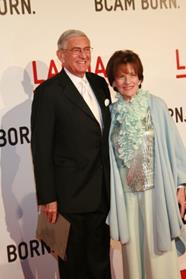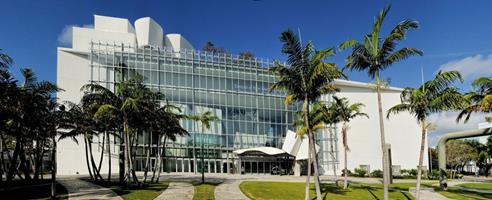Years ago a school district superintendent put the Broad Foundation in touch with me about The Broad Academy. The Academy recruited people from military backgrounds, the business world, and academia for intensive two-year fellowships to develop education leaders. All program expenses and travel were covered. In return, students committed to seeking jobs as urban school district superintendents after graduation.
When I researched the Foundation, I learned it was funded by Eli Broad. I was amazed by the thought and resources Broad was putting into improving education in America. I also came across the Broad Art Foundation. But before we get to art, let’s get to know Broad, starting with his surname. He changed its spelling and pronunciation when he was in junior high school, pronouncing it as though spelled “brode.” (Knowing how to say his name gives you instant art cred.)
Billionaire Broad
Broad was born in 1933 in New York City. At 20, he was a CPA in Michigan. At 24, he and Donald Kaufman started Kaufman and Broad (now KB Home). He moved to Los Angeles after Kaufman retired and bought a small insurance company that he grew into SunAmerica, making him the only person to found two Fortune 500 companies in different industries. Broad has consistently appeared on the Forbes list of billionaires with recent net worth estimated at $6.9 billion.
Eli and his wife, Edythe, were patrons and champions of art. They amassed a contemporary collection that was not hidden behind the gates of their home, but not exactly accessible to the public either. Instead, they generously made the collection available to researchers and for loan to museums, what they called a lending library.
The Broads supported the arts in meaningful ways. They also showed their love for their adopted city of Los Angeles by acts of leadership and philanthropy. The story of the Walt Disney Concert Hall is a good example.
Walt Disney Concert Hall
In 1987 Lillian Disney, Walt’s wife, made a $50 million gift to kick off a project to build a new concert hall in downtown L.A. The underground parking garage was built by the county for $110 million. But fundraising for the hall stalled and construction stopped.

Broad and the Mayor stepped in, rallying the philanthropic troops to raise $225 million, of which The Broad Foundation donated $15 million. As a result, the Frank Gehry*-designed Walt Disney Concert Hall* opened in 2003 at 1st & Grand Avenue, a big part of a downtown L.A. revival. The monumental and modern Cathedral of Our Lady of the Angels had opened the year before, just 1600 feet away down Grand Avenue. The Concert Hall is a metal feather in L.A.’s cap, an iconic building that elevated the city’s standing as a national arts center.
MOCA and LACMA
In the 1970s, Broad was the founding chairman of the Museum of Contemporary Art, located a block down the street from the Concert Hall. But MOCA fell on hard times and was rescued in 2008 by Broad’s $30 million gift.

Eli was also on the board of the Los Angeles County Museum of Art.* (For more art cred, refer to it as “lacma.”). LACMA is fun to visit, with various pavilions spread across 20 acres and interactive outdoor art. The Broads donated $50 million to build another pavilion, The Broad Contemporary Art Museum, that opened in 2008. That led to speculation that the entire Broad collection would eventually be given to LACMA. But like most museums, LACMA would not commit to permanent showing of most of their collection. So the Broads announced plans for a new art museum to be called, simply, The Broad.* The lending library would have a home for storage and exhibition.
The Broad
I saw Eli Broad in 2013 during Art Basel Miami Beach when he was on a panel with the architect and the founding director discussing designing the new museum. He seemed to be a soft-spoken man, neither showy nor haughty, as one might expect from a billionaire.

Of course, hearing about the new museum was exciting, but there were two bonuses. One is that it took place in the New World Center designed by Frank Gehry. The other is that Jeff Koons* was sitting in the front row, supporting Broad, his friend and patron. One of the architectural challenges of The Broad was its location across the street from the Concert Hall. (MOCA is across the other street.) The new building had to be a worthy complement to the Hall, noteworthy but not competing with it.

The result is a white building that is a veil of 2500 unique panels that each let in light, a contrast to the Hall’s metallic, windowless walls. It is a concrete example (pun intended) of the Broad’s commitment to visual art and to downtown L.A.
The museum opened in 2015 with admission free of charge. When I visited a year later, timed tickets were being used due to its popularity.
Legacy
The Eli and Edythe Broad Foundation has spent over $600 million to support public K-12 school systems across the country and funded over $110 million in scientific and medical research in areas like genomics, stem cell research, and inflammatory bowel disease. And in addition to the art projects we have talked about, The Broad Art Foundation has funded a $33 million art museum at Michigan State University and has given $23.2 million for the Broad Art Center at UCLA and over $14 million to LA Opera. In total, the Broads have contributed over $4 billion over the years across all of their causes.
I was saddened upon hearing of Eli Broad’s passing on April 30. But I know his contributions to art, education, and science live on.
* To be featured in a future post.

I look forward to learning more about Frank Gehry, Jeff Koons and LACMA. I look forward to traveling again and visiting the Los Angeles museums, especially the Broad!